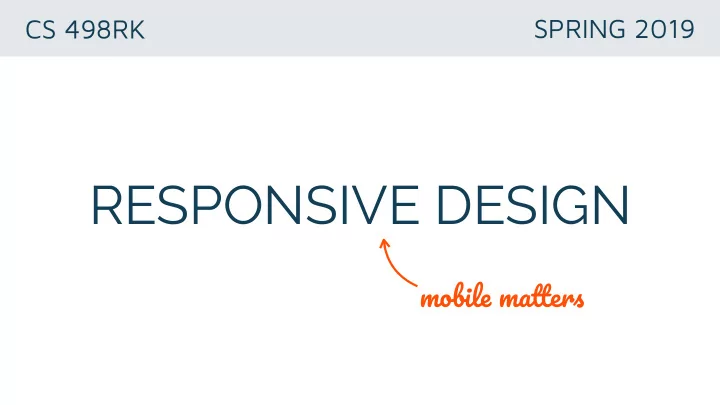

CS 498RK SPRING 2019 RESPONSIVE DESIGN mobil e ma tu e rs
ide a A website should look good on every display, from wide screens to mobile devices.
RESPONSIVE DESIGN ‣ Eliminates the distinction between mobile and desktop websites. ‣ Allows a single codebase that is displayed di ff erently in various screen sizes ‣ Achieved through media queries https://developers.google.com/web/fundamentals/design-and-ux/responsive/
49% Mobile Desktop 47% Tablet 4%
https://internetingishard.com/html-and-css/responsive-design
MEDIA QUERIES @media only screen and (min-width: 961px) { <regular-css-rules> }
MEDIA QUERIES a t -rul e medi a featur e @media only screen and (min-width: 961px) { <regular-css-rules> } medi a typ e
VIEWPORT ZOOMING ‣ By default, mobile devices zoom out to fit entire desktop layout onto the viewport. ‣ This prevents mobile devices from rendering responsive designs, ‣ In order to disable it, we need to specify a <meta> tag in the <head> <meta name='viewport' content='width=device-width, initial-scale=1.0'/> https://internetingishard.com/html-and-css/responsive-design
DESIGN ‣ Start with the design of how the website will look at every breakpoint. ‣ Various responsive design patterns exist. (Mostly Fluid, Column Drop, Layout Shi fu er, etc.) ‣ Implement them using media queries. ‣ We will use Layout Shi fu er. https://internetingishard.com/html-and-css/responsive-design
DESIGN ‣ Fluid Layout: Content stretches/shrinks to fill the entire viewport. ‣ Fixed-Width Layout: Content has the same width regardless of the viewport ‣ Generally, Mobile/Tablet → Fluid, Desktop → Fixed-Width https://internetingishard.com/html-and-css/responsive-design
BASIC PRINCIPLES ‣ Mobile-First: Start implementing mobile version first to maximize code reuse. ‣ Choosing Breakpoints: Don’t need to be device specific (i.e. iPhone X vs Galaxy S9). Take advantage of ranges. ‣ Relative vs Static Units: Use relative units when you want your content to adapt (when you don’t have enough screen real-estate), static units when you want the same look (when you have enough space). http://blog.froont.com/9-basic-principles-of-responsive-web-design/
dem o https:/ /github.com/uiuc- web-programming/ responsive-demo
RESOURCES https://internetingishard.com/html-and-css/responsive-design https://developers.google.com/web/fundamentals/design-and-ux/responsive/ https://alistapart.com/article/responsive-web-design/ http://gs.statcounter.com/platform-market-share/desktop-mobile-tablet
Recommend
More recommend